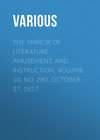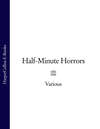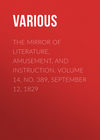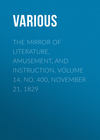Czytaj książkę: «The Mirror of Literature, Amusement, and Instruction. Volume 10, No. 280, October 27, 1827», strona 4
ARCANA OF SCIENCE
Sheppey.—The isle of Sheppey is quickly giving way to the sea, and if measures are not hereafter taken to remedy this, possibly in a century or two hence its name may be required to be obliterated from the map. Whole acres, with houses upon them, have been carried away in a single storm, while clay shallows, sprinkled with sand and gravel, which stretch a full mile beyond the verge of the cliff, over which the sea now sweeps, demonstrate the original area of the island. From the blue clay of which these cliffs are composed may be culled out specimens of all the fishes, fruits, and trees, which abounded in Britain before the birth of Noah; and the traveller may consequently handle fish which swam, and fruit which grew, in the days of the antediluvians, all now converted into sound stone, by the petrifying qualities of the soil in which they are imbedded. Here are lobsters, crabs, and nautili, presenting almost the same reality as those we now see crawling and floating about; branches of trees, too, in as perfect order as when lopped from their parent stems; and trunks of them, twelve feet in length and two or three diameter, fit, in all appearance, for the operations of the saw, with great varieties of fruits, resembling more those of tropical climates than of cold latitudes like ours, one species having a large kernel, with an adherent stalk, as complete as when newly plucked from the tree that produced it. An interesting collection of these relics of a former world may be seen at a watchmaker's on the cliff, at Margate, including the most remarkable productions of the isle of Sheppey.
The Camelopard

As a live camelopard has been sent to London and another to Paris, the history and habits of these animals have excited some interest. At a meeting of the Academy of Sciences in Paris, on the 2nd of July last, M. Geoffroy Saint-Hilaire observed that naturalists were wrong in supposing that there was only one species of the camelopard. The animal now in Paris differs from the Cape of Good Hope species by several essential anatomical characters, and he proposes to distinguish it by the name of the Giraffe of Sennaar, the country from which it comes. Some natives of Egypt having come to see the one in Paris in the costume of the country, the animal gave evident proofs of joy, and loaded them with caresses. This fact is explained by the circumstance that the Giraffe has an ardent affection for its Arabian keeper, and that it naturally is delighted with the sight of the turban and the costume of its keeper.
Some authors have proved the mildness and docility of the camelopard, while others represent it as incapable of being tamed. This difference is ascribed by M. Saint-Hilaire to difference of education. Four or five years ago a male Giraffe, extremely savage, was brought to Constantinople. The keeper of the present Giraffe had also the charge of this one, and he ascribes its savageness entirely to the manner in which it was treated. At the same time M. Mongez read a memoir on the testimony of ancient authors respecting the Giraffe. Moses is the first author who speaks of it. As Aristotle does not mention it, M. Mongez supposes that it was unknown to the Greeks, and that it did not then exist in Egypt, otherwise Aristotle, who travelled there, must have known about it. In the year 708 of Rome, Julius Caesar brought one to Europe, and the Roman emperors afterwards exhibited them at Rome, either for the games in the circus, or in their triumphs over the African princes. Albertus Magnus, in his Treatise de Animalibus, is the first modern author who speaks of the Giraffe. In 1486, one of the Medici family possessed one at Florence, where it lived for a considerable time.
In its native country the Giraffe browses on the twigs of trees, preferring plants of the Mimosa genus; but it appears that it can without inconvenience subsist on other vegetable food. The one kept at Florence fed on the fruits of the country, and chiefly on apples, which it begged from the inhabitants of the first storeys of the houses. The one now in Paris, from its having been accustomed in early life to the food prepared by the Arabs for their camels, is fed on mixed grains bruised, such as maize, barley, &c., and it is furnished with milk for drink morning and evening. It however willingly accepts fruits and the branches of the acacia which are presented to it. It seizes the leaves with its long rugous and narrow tongue by rolling it about them, and seems annoyed when it is obliged to take any thing from the ground, which it seems to do with difficulty. To accomplish this it stretches first one, then the other of its long fore-legs asunder, and it is not till after repeated attempts that it is able to seize the objects with its lips and tongue.
The pace of the Giraffe is an amble, though when pursued it flies with extreme rapidity, but the small size of its lungs prevents it from supporting a lengthened chase. The Giraffe defends itself against the lion, its principal enemy, with its fore feet, with which it strikes with such force as often to repulse him. The specimen in the museum at Paris is about two years and a half old.
The name Camelo-pardalis (camel-leopard) was given by the Romans to this animal, from a fancied combination of the characters of the camel and leopard; but its ancient denomination was Zurapha, from which the name Giraffe has been adopted.—Brewster's Journal.
Sugar
About 3,700,000 cwt. of sugar are annually imported from the West Indies. An advance in price, therefore, of one penny per pound is a charge on the public of 1,726,600l. a year, being more than one-third of the gross amount of the duty levied at the Custom-house for the revenue.
Silk
Lord Kingston has upwards of 30,000 mulberry-trees growing upon one estate in Ireland, and has already sent raw silk into the market.
SINGULAR ASSASSINATION IN KINCARDINESHIRE
(For the Mirror.)
The fate of one of the sheriffs of this county, in former times, merits notice, especially as connected with a ruin in the parish of Eccliscraig, formerly a place of great strength, being erected on a perpendicular and peninsulated rock, sixty feet above the sea, at the mouth of a small rivulet. It was built in consequence of a murder committed in the reign of James the First, and the circumstance deserves to be recorded, as it affords a specimen of the barbarity of the times. Melville, sheriff of Kincardineshire, had, by a vigorous exercise of his authority, rendered himself so very obnoxious to the barons of the county, that they had made repeated complaints to the king. On the last of these occasions the king, in a fit of impatience, happened to say to Barclay, of Mathers, "I wish that sheriff were sodden and supped in brue." Barclay instantly withdrew, and reported to his neighbours the king's words, which they resolved literally to fulfil. Accordingly, the conspirators invited the unsuspecting Melville to a hunting party in the forest of Garvock; where, having a fire kindled, and a cauldron of water boiling on it, they rushed to the spot, stripped the sheriff naked, and threw him headlong into the boiling vessel: after which, on pretence of fulfilling the royal mandate, each swallowed a spoonful of the broth. After this cannibal feast, Barclay, to screen himself from the vengeance of the king, built this fortress, which before the invention of gunpowder must have been impregnable. Some of the conspirators were afterwards pardoned. One of the pardons is said to be still in existence; and the reason assigned for granting it is, that the conspirator was within the tenth degree of kin to Macduff, thane of Fife.
CHARLES STUART.
USE OF HORSE-CHESTNUTS
(For the Mirror.)
These nuts are much used in France and in Switzerland, in whitening not only of hemp and flax, but also of silk and wool. They contain a soapy juice, fit for washing of linens and stuffs, for milling of caps and stockings, &c., and for fulling of stuffs and cloths.
Twenty nuts are sufficient for five quarts of water. They must be first peeled, which can be done by children, then rasped or dried, and ground in a malt-mill, or any other common steel mill. The water must be soft, either rain or river water, for hard well water will by no means do. When the nuts are rasped or ground, they must be steeped in the water quite cold, which soon becomes frothy, (as it does with soap,) and then turns white as milk. It must be well stirred at first with a stick, and then, after standing some time to settle, must be strained, or poured off quite clear. Linen washed in this liquor, and afterwards rinsed in clear running water, takes an agreeable light sky-blue colour. It takes spots out of both linen and woollen, and never damages or injures the cloth. Poultry will eat the meal of them, if it is steeped in hot water, and mixed with an equal quantity of pollard. The nuts also are eat by some cows, and without hurting their milk; but they are excellent for horses whose wind is injured.
A.B.




















